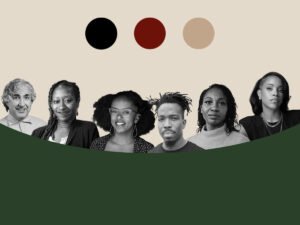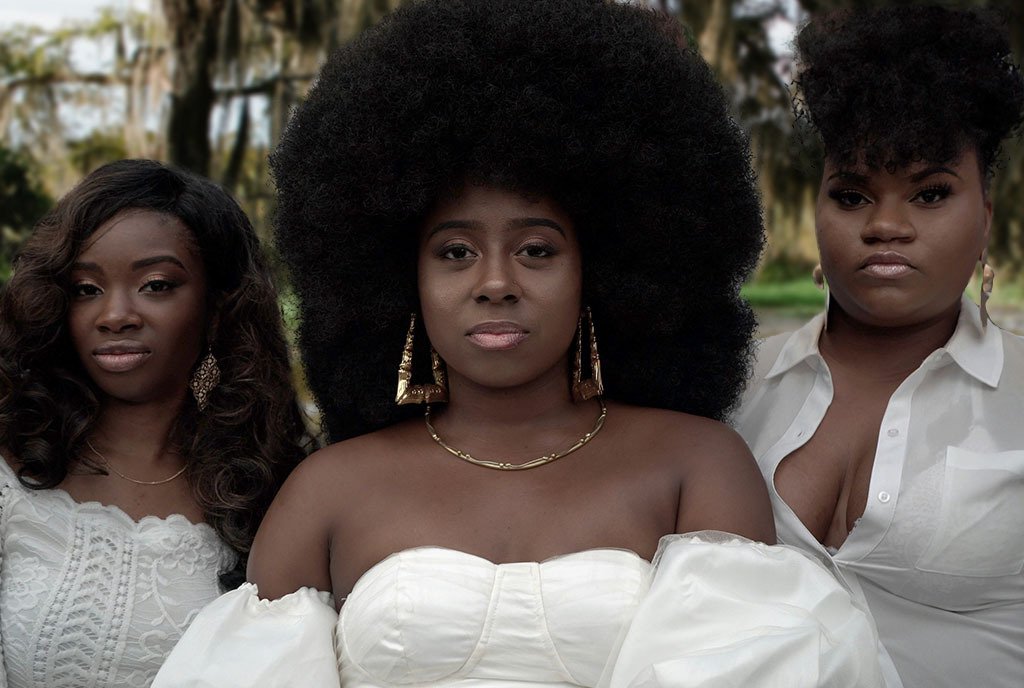
Over the last two years, I’ve received many calls from racial justice consultants and practitioners. The two main requests have been for new models and to be convened as a community of practitioners. So, in January of this year, Edge Leadership, an R+D platform for social change hosted by NPQ, hosted a roundtable series on the state of race and power in the field.
The Context
The first roundtable was held a few days after the assault on the Capitol, and the event was fresh in participants’ minds. Kelly Bates, president of Interaction Institute for Social Change, puts it plainly: “We’re in a battle for power.” The way she sees it, many white people in the US feel they are losing their power to dominate, and they are willing to try to take it back by force.
Angela N. Romans, interim executive director at Achieve Mission, adds that much of the conflict around race right now is not physical and, importantly, is the result of “wins on our side,” the result of “a shift of power that’s happening slowly.” She points to the Democrats’ wins in Georgia that were led by black women organizing, as an example.
Kad Smith, an independent consultant, sees it as a global issue: “The global majority has successfully started to articulate the impact of race as a construct in ways that we’ve never seen before. Technology and access to information have allowed for that kind of permeation of a colorblind society to not be able to continue…. And the global majority has been very successful. People of color across the world are saying, no, the impact is still very much felt, and I can point you to a thousand ways where I see it every day, and you no longer have the privilege of not listening.”
Anastasia Tomkin, writer and direct support professional at Common Justice, agrees. “These conversations are being had, they’re bubbling up, almost reaching a crescendo.” But, as someone working in the justice system, Tomkin points out that the outcomes have not been so great, and the alternatives coming forward are not viable.
Manisha Patel, who just left the National Health Service (NHS) to launch a consulting practice focused on coaching leaders of color, shared that it is not very different in the United Kingdom with Brexit—a white majority seeing itself as beleaguered. She explains, “I live in Britain, where racism started. Their systems are deeply, deeply historically embedded in how power is created, who has the power, who doesn’t have the power. And there’s also the scarcity model…. ‘If I give up my power, then my children won’t have these privileges that I’ve had, the people like me won’t have it. I’ll have to give it to somebody else who’s not like me, who I’m afraid of, because they’re different, because I don’t have any relationship with these people.’ And that fear is very deep. So the systems here are designed very, very well. They serve white people really well.”
Nevertheless, Patel is noticing a real generational difference. She explains, “For the middle-aged to older generations, they are so suppressed, they’re used to putting up and shutting up, where the younger generations have driven that voice, which has helped other people to come in to talk about what they’ve been suffering for so many years in terms of the oppression.”
The Field
Increased Requests for Antiracism Consulting
Not surprisingly, participants report an increase in RFPs, RFQs, and LOIs requesting antiracism consulting services. These are also asking for consultancies led by people of color. Unfortunately, as one participant, Aisha Rios, founder and learning & change strategist at Coactive Change, said, “A lot of those calls ask for the moon and stars for $5,000 or $8,000 in three months.” She adds, “One thing that we’ve been doing is adding a one-page addendum or note to say why it’s problematic to call on Black and Brown indigenous bodies to put in this labor, in this really short timeline, with a really small budget. We’ve received really positive responses so far. There are ways in which those calls are perpetuating the harms and violence that they are trying to address.”
Monisha Kapila, founder and co-CEO of ProInspire, says that though much of this work started before 2020, it has accelerated over the last year. She’s focusing on supporting leaders of color in predominantly white organizations. She says, “They are feeling that this is a moment for them to own their power and push. But that is putting a lot of labor on them. And I think for the capacity builders who partner with them, we have to be really intentional about understanding the support that they need. Because it isn’t necessarily safe for them to push this change, but they know that this change is needed. Even though there’s support, oftentimes if you have, for example, white CEOs or mostly white boards, I think there’s this acknowledgment, we have to do this work, but there’s still subtle resistance to it.”
People of Color Focusing on Ourselves
As we narrow in from the wider contextual frame to our work in the field, Manisha Patel notes that Black and Brown workers, who’ve been at the forefront of fighting COVID, are beginning to put themselves first, to speak out about their need for safety, and that’s changing power dynamics. “But,” she says, “the people who run the systems are not using anything that’s different or innovative or radical. They want toolkits, policies—big organizational tools that don’t make change in terms of culture and power.”
Aja Couchois Duncan, senior consultant at Change Elemental, says that what’s most alive for her is the ways in which anti-Blackness shows up in communities of color. “Particularly,” she says, “the tensions between Black and Indigenous people because of our histories and the ways in which genocide and racism have been used.” She is part of a community of practice grappling with this, and she says, “I don’t want to talk about it with everybody.” She wonders how she can say to white people, “Skilled white facilitators are going to take care of you all because we have really important work to do to decolonize ourselves. That’s where my heart is right now.”
Challenging the Monopolization of Power
Kad Smith finds that “the state of power in our work is really starting to identify where power is being monopolized, where power is being hoarded. And to speak plainly about why that has to change, specifically when we say we want to be collaborative, specifically when we say we want to be equitable.”
We are at a choice point, much like in the civil rights movement, when people are challenging core supremacist beliefs and practices. Anastasia Tomkin reflects on what it took our forebears to challenge the oppressive beliefs and practices of their time, particularly how they bridged the gap of impossibility and fear: “Sometimes I put myself in the shoes of people back in the days of slavery, and how brave they had to be to organize and push people to actually fight back. Then even closer, in the days of segregation, masses of people followed ‘Whites Only,’ ‘Colored Only’ signs for years. And it makes me wonder, is it really just the one-off random people who actually—like Rosa Parks who sat on the bus, and the woman who did it before her—were like, ‘Hey, we should actually do this.’ And then some kind of fear held them back. Some idea that, ‘No, this is the power. This is how it is. We can’t do that. We can’t bridge this gap. It’s impossible. It’s dangerous.’ But then, eventually it did happen, and there were the sit-ins. And, I think, once again, we’re back in a moment where we have the power to push this forward.”
Monna Wong, chief content officer at the Management Center, differentiates between the power over others that white supremacists seek to hold on to and the power social change agents seek: “What we’re seeing is people who are devastated by the fact that their power over others is being challenged. I think what our side is not fighting for is power over others. We’re fighting for the ability to self-determine for ourselves, that’s why we organize—we’re building power for our communities so that we can determine our outcomes. What we’re winning is the ability to have, to practice self-determination.”
Understanding the Process of Transformation
Danielle Coates-Connor, founder of Infinite Growth, says, “We’ve seen a lot of this successfully happen in movements across the African continent, such as Tostan, where people aligning around vision and values is a perfect gateway to them to then being able to make decisions about which of the social norms need to be updated. And when you update things at the level of social norms, at the level of assumption, and you start to build structures around what is sanctioned and what is rewarded in the society, you begin to get momentum for this kind of transformational change, and we don’t see this type of violence occurring anymore.”
In my study of how social change happens, I’m narrowing in on the process of transformation and understanding what it means when we ask people to change, to transform. What does that look like? What are the phases? It’s a different kind of organizing around consciousness.
Angela Romans asks, “When is it our role to support people in their transformation? And when is it our role to force people to step aside, or to help support the people who are organizing around the stepping aside?” She notes that sometimes the leader is a blocker who gaslights those seeking change: “They say ‘this place isn’t safe.’ What do they mean by that? They don’t mean physically unsafe. I mean, they’re not physically unsafe. I don’t get it.” When she sees this, she asks the change-seeking staff, “How can I or other people support you in your own growth and transformation? What’s within the bounds of your authority to change, within your team, with your colleagues?” Until they get to the point where there is enough resistance in the organization that the leader has to shift or step aside. Mostly, she says, “It’s time for a lot of people to step aside.”
Manisha Patel thinks we have to move beyond seeking to change systems. “I don’t believe we can necessarily change some of these systems because of how they’re designed and how everything is so historically embedded. But I liked what Danielle [Coates-Connor] said about starting new systems by thinking differently, and maybe then those systems will become attractive to people who are quite conditioned in the old way. How you start that education piece around power and what choices you really have, because I don’t think people are aware of their choices.”
I think about power as choice expansion. How do you create more choices for yourself? That’s being practical. At NPQ, we’re doing that by being in experimentation mode. We’re not trying to create the final product. I find that people get excited about that.
People of Color Leading Differently
Isabelle Moses, director of organizational development at Faith in Action, is seeing transitions from white-led organizations to organizations led by people of color. She adds, “Leaders of color are really looking to embody different ways of leading organizations that don’t replicate the harmful practices that we know are really oppressive.” This work requires investment in these change practices. Key to this is providing “more space and care and not work at destructive paces.” She notes that leaders of color are “resetting expectations of what a normal workload looks like and dismantling practices around urgency.”
Moses finds that there is a particular trend of black women leaders needing to dismantle harmful stereotypes. She finds that they want to do that work in community with other black women leaders. Faith in Action’s black women’s caucus has engaged Dr. Donna Coltrane Battle, who, as Moses says, “has been doing work on archetypes of strong black women, where those archetypes come from, and how do we disrupt some of those frameworks that are actually not serving us in our leadership and leading to martyrdom and other ways of being that are ultimately pretty harmful.” She highlights that the work being done to answer these two questions—“How do we support black women’s leadership in a really powerful way?” and “How do we support the transition from white-led to people-of-color-led organizations?”—is under-resourced.
Sign up for our free newsletters
Subscribe to NPQ's newsletters to have our top stories delivered directly to your inbox.
By signing up, you agree to our privacy policy and terms of use, and to receive messages from NPQ and our partners.
Experimenting with Forms
Lucia Castaneda Kimble, director of Training + Curriculum at Rockwood Leadership Institute, says that oftentimes when leaders of color ascend into leadership, their values ultimately come into conflict with the nonprofit structures themselves. They ask questions like: “How do we pay folks more equitably? What kind of policies do we need?” She wonders, “How much can we move within? And where are we creating the sort of alternatives radically transformed structures that we’re going to need?”
Kad Smith observes some changes in the sector in terms of forms. The first is a rise in organized labor as part of racial justice work. “If people fear that they’re going to lose their job when they speak truth to power, then we need some type of mechanism to assure them that that will not be the case. I’m seeing staff who are literally organizing themselves. They have a list of demands. They have representatives that can position them in a way to be responded to differently.”
He is also seeing more cooperative models. “I love the work of AORTA [the Anti-Oppression Resource and Training Alliance]. I love the work of people who say, ‘I’m invested in this organization with an ownership lens, not in an extractive capitalist way, but my belonging here is bigger than just a paycheck. So my view of what matters to this organization has a longer lifespan than what would be traditional when you’re just coming into an organization.’ How is the idea of being in a cooperative-based space really informing for how you show up?”
Isabelle Moses is seeing a shift toward people not wanting to work in organizations at all. Staff are leaving at younger ages. She says, “I have a part-time LLC because I didn’t want to be wholly owned by an organization. And I know a number of people who are quitting and saying, ‘I’m going to just do my own thing, or be a gig worker, or create contract projects,’ because this organizational model is not working for a lot of us. This idea of being 100-percent devoted to an organization feels like its own form of oppression. I think we have to pay attention to these trends around how people are reclaiming power and liberation, and creating new ways of monetizing our brilliance that are not set by somebody else’s standard or somebody else’s terms, and getting to rewrite the rules about how much I want to be compensated and how I want to spend my time. Then there’s the question of individualism, but then there’s also a lot of interdependence in that, because people are figuring out how to create our own networks. How do I find the people that are like-minded that I want to build with? I can create my own sense of community and coworkers. I find that to be such an interesting trend, particularly among race equity practitioners.”
What’s Needed Now
Space to Imagine
Noah Kruis, an organizer and trainer with Crossroads Antiracism Organizing and Training, says, “What’s a future that we can imagine that’s breaking out of the norms and constraints that we have that are shaping us and really inhibiting our imagination? Because having that vision of what could be maybe makes the discomfort between here and there worth it for those who are afraid of that discomfort.”
For many, this includes, as Angela Romans puts it, “Space for white folks to do their work, cry their tears, absolutely. And a space for women of color leaders especially.” Romans says it is especially tough for leaders of color, who face internal pressure from staff who don’t feel they are moving fast enough, and external pressure in the form of white dominant society not moving fast enough. “And also, leaders of color need space to talk about taking risks,” she adds.
Kad Smith agrees, “We need tons of these discussions and forums for women of color. The field is not crowded.” He adds that we also need spaces to build solidarity across identities. For himself, “I’m looking for a space for imagination and creativity. That’s something that I think a lot about. I’m also in the midst of deep reading of Octavia Butler, and this real notion of, how do we actually imagine something completely different in a way that isn’t necessarily rooted or connected to this thing that we’re trying to move away from? Because if we’re always in reactivity to that, aren’t we in some odd way also holding on to and perpetuating those notions?”
Kai Fierle-Hedrick, founder of Create Knowledge, also agrees that there is “a call for something different, to not just try and transform or build off of what exists, but there’s also a lot of anxiety around that.” Leaders are asking, “‘What do I put out there if I’m not using what exists before?’ It can be experienced as a real block. ‘How do I imagine that?’” She thinks there is a lack of practice in the nonprofit sector around this creative work, even in her own work: “There are feelings of urgency (real and manufactured) and a lack of time and resources that leaves too little space or energy for creative thinking and dreaming. One of my goals for this year is trying to carve out more of that space too. Because I’m realizing how full I have made my days and the impact that’s having on my own work and my ability to imagine.”
Steve Lew, project director at CompassPoint, recounts his journey into the nonprofit sector. “My entry point was thinking about liberation and solidarity, as to values and practices. Then moving into nonprofit organizations, that translated into very different ways of doing things. What I’m really yearning for is to be in conversation with people who came into nonprofit work with the liberation perspective. We tried to hold on to some of those visions, but there was huge pressure for BIPOC leaders to assimilate into those institutions that were forming in the ’70s and ’80s. So, I think that could be really useful thinking about the ways in which we gave up some of our visions in order to make a way, and when we’re supporting young leaders of color, we may be doing it in a way that could be harmful.”
Aisha Rios says, “Being in spaces where you’re imagining and creating something different is so valuable, and I want more of those spaces in my life. But then at the same time, being in spaces of reform and resistance is also part of the work. For me, that’s so draining, especially when they those predominantly white spaces. And so I figure it out for myself, the right balance for me, personally, of doing both, all those different lanes of work, making sure that I’m not only in the reform and resistance spaces because I just can’t physically do it. So that’s been helpful for me to think about all the different projects that I’m engaged in and finding a balance that feels good. I feel rejuvenated in the creation and imagination spaces, and then I feel resourced to go into those resistance and reform spaces.”
Rethinking Leadership
Anastasia Tomkin argues that leadership is the biggest problem in a lot of organizations. She says, “The power that leadership has is so directly connected to money.” She thinks we have to separate leadership from the ability to raise money. “There are ways to make sure that just because they are bringing in the money, they’re actually not making decisions anymore, or that their opinion in the work, because it’s Black liberation–oriented work, and they’re not Black, their opinions and stuff would not hold as much weight as ours would, because it just makes sense.”
Kad Smith adds, “We also need to change our relationship to how we think about leaders. What it is they’re there to do, what it is we hold them accountable for, and what it is that we don’t need from them. The things that are available to us as a collective, and power within. So we don’t set them up as well. Because it’s not an easy time, in my opinion, to lead right now. I’ve talked to several folks who’ve said they felt in their leadership positions that people are seeing power as pejorative. If you have power, you are their enemy.”
Manisha Patel agrees. “I would love to think about leadership in different terms. Like as a relay race. When I think about what it was like for me to lead an organization, I felt like I was doing as much as I could, and then when it was time for me to be done, I passed it on. And the person after me did the best that they could.”
Monisha Kapila notes that there is tension around how to support leaders of color. She says, “I think there’s a lot more movement towards shared leadership models that really align more with values. And we need to be careful that, in this moment when we have a lot more BIPOC CEOs—we’re not all of a sudden asking them to share their leadership, when the white CEOs before them weren’t asked. I really struggle with this. Because if BIPOC CEOs want to have it be shared leadership, then we should support them. But let’s not expect that from them. Because this is actually their moment to lead.”
Aja Couchois Duncan agrees. “I’m experiencing some people and organizations getting really fundamentalist about shared leadership, or equity and compensation. I just saw a job posting for a really big job and it stated that it would only pay $100,000 because it is doing a one to two ratio on salaries. And I thought, ‘So you’re gonna cap the top, rather than lifting everyone up, because you think that’s equitable compensation?’ The same thing with shared leadership—it takes more time and energy. It can be beautiful and amazing. It can also be really difficult and extractive. And I just feel like we can’t talk about all of it. We are not holding the complexity.”
Creating New Forms and Norms
Anastasia Tomkin invites us to create new responses to white fragility. She asks, “What if when we’re in the context where they’re weaponizing their tears in a conversation about race, everybody in the room collectively agrees that person is going to step out immediately, collect themselves, and then return when they’re not going to do that? And everybody who feels sorry for her can also walk out of the room and collect themselves and come back when they’re ready to move forward. We have to figure out how to practically make these small changes where we can move from everything being oriented towards coddling white people, to centering our needs.”
Asha Mehta says she stopped saying she does equity work because she wanted to move beyond the limited expectations of that frame. “I’m like, ‘Are you all ready to build community?’” She says equity work is “a call from a rich white organization that wants me to solve their problem, usually with a training.” But, she says, “We’ve got to talk about hiring. There are systems to change, there’s the inside job. There’s a whole thing.”
Kad Smith agrees. “The idea that our workplaces should feel more community centric is now becoming a norm that we’re rallying behind. If our work needs to feel like community, where we have values, where we’re striving to live into them, that challenges everything about how we operate with one another, how we engage with one another. And so I think Asha [Mehta] is completely right around where the call comes from. Sometimes it’s a preservation of the status quo; it’s to protect the comfort of folks who already have power. And when that’s the starting point, the work is going to be shortsighted. But when the work is coming from, ‘How do we reconcile all these multiple truths?’ There’s going to be discomfort, and we’re trying to create a space where that discomfort can lead to growth, can lead to learning, and can allow for us to develop more formative connections. That is the opportunity of this moment. There’s the coded language and the kind of surface level stuff— DEI, antiracism, etc. But it’s a real invitation for us to go deeper in ways that in my short life, I’ve never seen across sectors, across workplaces. It feels very promising.”
Mehta adds, “I think we need a basic level of health. I see so many people struggling—physically, mentally, emotionally—burnt out by the systems.” For her, it’s more than self-care: “There’s something about rhythm. We need sustainable rhythms in our lives, in people’s lives. That requires saying no to a bunch of stuff and thinking about life as more.” Christina Garcia, an independent consultant, agrees: “The idea of rhythm resonates with me. Also, having to constantly have the courage and the energy to push back on all of the forces that try to turn an individual rhythm into a universal one.” She experiences this in her consulting. She asks herself. “How much do I match their rhythm? And how much am I intentionally helping them by bridging to a rhythm that feels more holistic, more human, more embodied that gives everyone that ability to actually do work in relationship with one another and actually see the value of being in relationship with one another as a critical component of finding our way to something new?”
Isabelle Moses is specific about what she’d like to see from Edge Leadership. “I know that there are a handful of discrete questions that I could imagine being great prompts for non-continuous cohorts of folks coming together periodically. A calendar that tells us, ‘This week, we’re going to talk about x. And this other week, we’re going to talk about y. And this week, we’re gonna talk about z. Questions around equitable compensation structure, and how to understand flat structures and hierarchies. What have we learned? What’s working, not working? I’m particularly thinking about how to build healthy, sustainable organizations that center the lived experiences of BIPOC folks.” Steve Lew agrees. “I wonder what it’d be like for folks who, like myself, are really steeped in this area of practice—how to move from reform into more liberating practices—to talk about those practices versus just frames.” Mehta, too: “When we were talking about that dance between choosing out of the nonprofit system, and then networking as a new form, that got me really excited about trying to figure out how to talk about that. I would love reading a paragraph or watching a video. And then I want to talk about forms more. That would be fun to be sparked by something and then come in.” Smith has questions he’d like to explore too. “There’s something around right risk. What are the risks that I should take? When do I take it? And how do I encourage other folks to sit with that for themselves?”
Conclusion
It is clear from these voices that race and power work has accelerated over the last year. While those who are just starting on this developmental journey may think it is about tweaking what exists, those who have been in it for a while know that it is about rethinking everything. And there is a critical need for this creative process to be nurtured. These leaders overwhelmingly want space to imagine. They want to center the needs and desires of people of color in this work. They want to rethink leadership. They want to bring new forms and norms into the work. Essentially, they want to create liberatory practices and unearth the ones that already exist but are subordinated.













